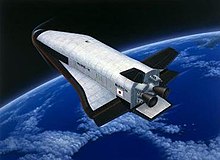 HOPE-X | |
| Country of origin | Japan |
|---|---|
| Size | |
| Height | 15.2 m (50 ft)[1] |
| Diameter | 9.7 m (32 ft) (wing span)[1] |
| Mass | 14 t (31,000 lb)[1] |
| Stages | launched on H-IIA |
| Launch history | |
| Status | Project cancelled |
HOPE (H-II Orbiting Plane) was a Japanese experimental spaceplane project designed by a partnership between NASDA and NAL (both now part of JAXA), started in the 1980s. It was positioned for most of its lifetime as one of the main Japanese contributions to the International Space Station, the other being the Japanese Experiment Module. The project was eventually cancelled in 2003, by which point test flights of a sub-scale testbed had flown successfully.